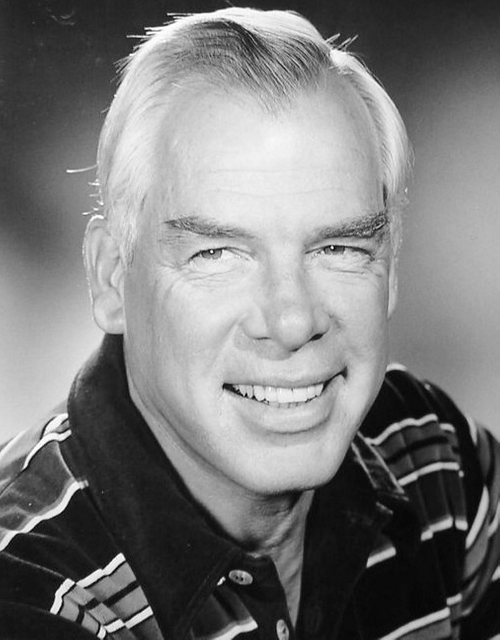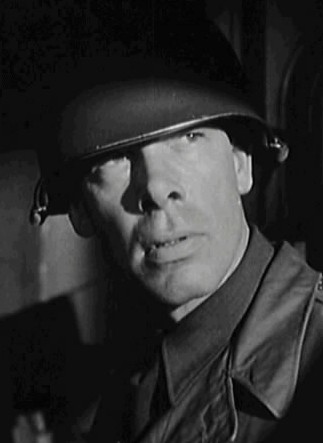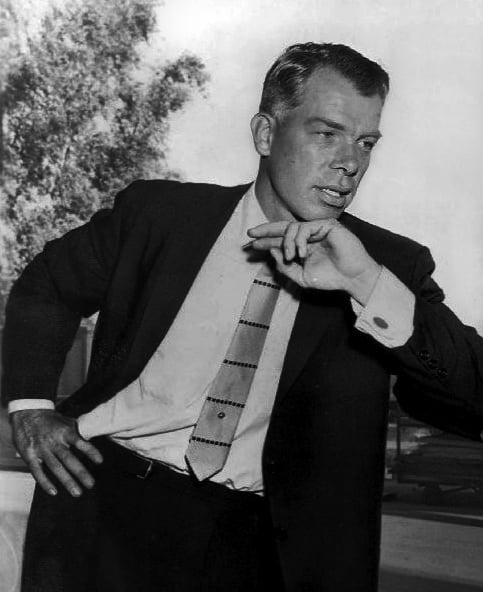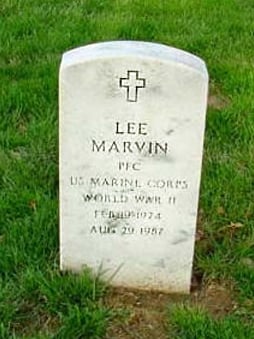Lee Marvin

Lee Marvin

Lee Marvin | |
|---|---|
| Born | (1924-02-19)February 19, 1924 New York City, U.S. |
| Died | August 29, 1987(1987-08-29)(aged 63) Tucson, Arizona, U.S. |
| Resting place | Arlington National Cemetery |
| Residence | Tucson, Arizona, U.S. |
| Education | Manumit School St. Leo College Preparatory School |
| Occupation | Actor |
| Years active | 1948–1986 |
| Spouse(s) | Betty Ebeling (m. 1951;div. 1967) Pamela Feeley (m. 1970) |
| Partner(s) | Michelle Triola (1965–1970) |
| Children | 4 |
| Military career | |
| Allegiance | |
| Service/ | |
| Rank | |
| Unit | 24th Marine Regiment, 4th Marine Division |
| Battles/wars | World War II
|
| Awards | |
Lee Marvin (February 19, 1924 – August 29, 1987) was an American film and television actor.[2]
Known for his distinctive voice and premature white hair, Marvin initially appeared in supporting roles, mostly villains, soldiers, and other hardboiled characters. A prominent television role was that of Detective Lieutenant Frank Ballinger in the NBC crime series M Squad (1957–1960).
One of Marvin's most notable film projects was Cat Ballou (1965), a comedy Western in which he played dual roles. For portraying both gunfighter Kid Shelleen and criminal Tim Strawn, he won the Academy Award for Best Actor, along with a BAFTA Award, a Golden Globe Award, an NBR Award, and the Silver Bear for Best Actor.
Lee Marvin | |
|---|---|
| Born | (1924-02-19)February 19, 1924 New York City, U.S. |
| Died | August 29, 1987(1987-08-29)(aged 63) Tucson, Arizona, U.S. |
| Resting place | Arlington National Cemetery |
| Residence | Tucson, Arizona, U.S. |
| Education | Manumit School St. Leo College Preparatory School |
| Occupation | Actor |
| Years active | 1948–1986 |
| Spouse(s) | Betty Ebeling (m. 1951;div. 1967) Pamela Feeley (m. 1970) |
| Partner(s) | Michelle Triola (1965–1970) |
| Children | 4 |
| Military career | |
| Allegiance | |
| Service/ | |
| Rank | |
| Unit | 24th Marine Regiment, 4th Marine Division |
| Battles/wars | World War II
|
| Awards | |
Early life
Marvin was born in New York City. He was the son of Lamont Waltman Marvin, an advertising executive and later the head of the New York and New England Apple Institute, and Courtenay Washington (née Davidge), a fashion and beauty writer/editor.[3]
As with his elder brother, Robert, he was named in honor of Confederate General Robert E. Lee, who was his first cousin, four times removed. His father was a direct descendant of Matthew Marvin Sr., who emigrated from Great Bentley, Essex, England, in 1635, and helped found Hartford, Connecticut.[3]
Marvin studied violin when he was young.[4] As a teenager, Marvin "spent weekends and spare time hunting deer, puma, wild turkey, and bobwhite in the wilds of the then-uncharted Everglades".[5]
He attended Manumit School, a Christian socialist boarding school in Pawling, New York, during the late 1930s, and later attended St. Leo College Preparatory School, a Catholic school in St. Leo, Florida, after being expelled from several other schools for bad behavior.[6]
Military service
World War II
Marvin left school at 18 to enlist in the United States Marine Corps Reserve on August 12, 1942. He served with the 4th Marine Division in the Pacific Theater during World War II.[7] While serving as a member of "I" Company, 3rd Battalion, 24th Marines, 4th Marine Division, he was wounded in action on June 18, 1944, during the assault on Mount Tapochau in the Battle of Saipan, during which most of his company were casualties.[8] He was hit by machine gun fire, which severed his sciatic nerve,[9] and then was hit again in the foot by a sniper.[10] After over a year of medical treatment in naval hospitals, Marvin was given a medical discharge with the rank of private first class (he had been a corporal years earlier but had been demoted after causing trouble)[10] in 1945 Philadelphia.[11]
Marvin's military awards include: the Purple Heart Medal, the Presidential Unit Citation, the American Campaign Medal, the Asiatic-Pacific Campaign Medal, and the World War II Victory Medal, Combat Action Ribbon.
Acting career
Early acting career
After the war, while working as a plumber's assistant at a local community theatre in upstate New York, Marvin was asked to replace an actor who had fallen ill during rehearsals. He caught the acting bug and got a job with the company at $7 a week. He moved to Greenwich Village and used the GI Bill to study at the American Theatre Wing.[12][13]
Marvin began appearing on television shows like Escape, The Big Story, and Treasury Men in Action.
He made it to Broadway with a small role in a production of Uniform of Flesh, now called Billy Budd in February 1951.[16]
Hollywood
Marvin's film debut was in You're in the Navy Now (1951), directed by Henry Hathaway, a film which also marked the debuts of Charles Bronson and Jack Warden. This required some filming in Hollywood. Marvin decided to stay there.[12]
He had a similar small part in Teresa (1951) directed by Fred Zinnemann. As a decorated combat veteran, Marvin was a natural in war dramas, where he frequently assisted the director and other actors in realistically portraying infantry movement, arranging costumes, and the use of firearms.
He guest starred on episodes of Fireside Theatre, Suspense and Rebound. Hathaway used him again on Diplomatic Courier (1952) and he could be seen in Down Among the Sheltering Palms (1952), directed by Edmund Goulding, We're Not Married! (1952), also for Goulding, The Duel at Silver Creek (1952) directed by Don Siegel, and Hangman's Knot (1952), directed by Roy Huggins.
He guest starred on Biff Baker, U.S.A. and Dragnet, and had a decent role in a feature with Eight Iron Men (1952), a war film produced by Stanley Kramer (Marvin's role had been played on Broadway by Burt Lancaster).[17]
He was a sergeant in Seminole (1953), a Western directed by Budd Boetticher, and was a corporal in The Glory Brigade (1953), a Korean War film.
Marvin guest starred in The Doctor, *The Revlon Mirror Theater *, Suspense again and The Motorola Television Hour.
He was now in much demand for Westerns: The Stranger Wore a Gun (1953) with Randolph Scott, and Gun Fury (1953) with Rock Hudson.
The Big Heat and The Wild One

Marvin in Attack
Marvin received much acclaim for his portrayal as villains in two films: The Big Heat (1953) where he played Gloria Grahame's vicious boyfriend, directed by Fritz Lang; and The Wild One (1953) opposite Marlon Brando (Marvin's gang in the film was called "The Beetles"), produced by Kramer.[18]
He continued in TV shows such as The Plymouth Playhouse and The Pepsi-Cola Playhouse. He had support roles in Gorilla at Large (1954) and had a notable small role as smart-aleck sailor Meatball in The Caine Mutiny (1954), produced by Kramer.[12]
Marvin was in The Raid (1954), Center Stage, Medic and TV Reader's Digest.[19]
He had an excellent part as Hector, the small-town hood in Bad Day at Black Rock (1955) with Spencer Tracy.[20] Also in 1955, he played a conflicted, brutal bank-robber in Violent Saturday. A latter-day critic wrote of the character, "Marvin brings a multi-faceted complexity to the role and gives a great example of the early promise that launched his long and successful career."[21]
Marvin played Robert Mitchum's friend in Not as a Stranger (1955), a medical drama produced by Kramer. He had good support roles in A Life in the Balance (1955) (he was third billed), and Pete Kelly's Blues (1955) and appeared on TV in Jane Wyman Presents The Fireside Theatre and Studio One in Hollywood.
Marvin was in I Died a Thousand Times (1955) with Jack Palance, Shack Out on 101 (1955), Kraft Theatre, and Front Row Center.
Marvin was the villain in 7 Men from Now (1956) with Randolph Scott directed by Boetticher. He was second billed to Palance in Attack (1956) directed by Robert Aldrich.
Marvin had good roles in Pillars of the Sky (1956) with Jeff Chandler, The Rack (1956) with Paul Newman, Raintree County (1956) and The Missouri Traveler (1958). He also guest starred on Climax! (several times), Studio 57, The United States Steel Hour and Schlitz Playhouse.
M Squad

Marvin in 1959 from the set of M Squad
Marvin finally got to be a leading man in 100 episodes as Chicago cop Frank Ballinger in the successful 1957–1960 television series M Squad. One critic described the show as "a hyped-up, violent Dragnet ... with a hard-as-nails Marvin" playing a tough police lieutenant. Marvin received the role after guest-starring in a memorable Dragnet episode as a serial killer.[22]
When the series ended Marvin appeared on Westinghouse Desilu Playhouse, Sunday Showcase, The Barbara Stanwyck Show, The Americans, Wagon Train, Checkmate, General Electric Theater, Alcoa Premiere, The Investigators, Route 66 (he was injured during a fight scene[23]), Ben Casey, Bonanza, The Untouchables (several times), The Virginian, The Twilight Zone ("The Grave", "Steel") and The Dick Powell Theatre.[24]
Early 1960s
Marvin returned to features with a prominent role in The Comancheros (1961) starring John Wayne. He played in two more films with Wayne, both directed by John Ford: The Man Who Shot Liberty Valance (1962), and Donovan's Reef (1963). As the vicious Liberty Valance, Marvin played his first title role and held his own with two of the screen's biggest stars (Wayne and James Stewart).[25]
In 1962 Marvin appeared as Martin Kalig on the TV western The Virginian in the episode titled "It Tolls for Thee." He continued to guest star on shows like Combat!, Dr. Kildare and The Great Adventure. He did The Case Against Paul Ryker for Kraft Suspense Theatre.
For director Don Siegel, Marvin appeared in The Killers (1964) playing an efficient professional assassin alongside Clu Gulager. The Killers was also the first film in which Marvin received top billing.[26]
He guest starred on Bob Hope Presents the Chrysler Theatre.
Cat Ballou and stardom
Marvin finally became a star for his comic role in the offbeat Western Cat Ballou starring Jane Fonda. This was a surprise hit and Marvin won the 1965 Academy Award for Best Actor. He also won the 1965 Silver Bear for Best Actor at the 15th Berlin International Film Festival.[27]
Marvin next performed in the hit Western The Professionals (1966), in which he played the leader of a small band of skilled mercenaries (Burt Lancaster, Robert Ryan, and Woody Strode) rescuing a kidnap victim (Claudia Cardinale) shortly after the Mexican Revolution.
He followed that film with the hugely successful World War II epic The Dirty Dozen (1967) in which top-billed Marvin again portrayed an intrepid commander of a colorful group (future stars John Cassavetes, Charles Bronson, Telly Savalas, Jim Brown, and Donald Sutherland) performing an almost impossible mission. Robert Aldrich directed.
In the wake of these two films and after having received an Oscar, Marvin was a huge star, given enormous control over his next film Point Blank. In Point Blank, an influential film for director John Boorman, he portrayed a hard-nosed criminal bent on revenge. Marvin, who had selected Boorman himself for the director's slot, had a central role in the film's development, plot line, and staging.[24]
In 1968, Marvin also appeared in another Boorman film, the critically acclaimed but commercially unsuccessful World War II character study Hell in the Pacific, also starring famed Japanese actor Toshiro Mifune. John Boorman recounted his work with Lee Marvin on these two films and Marvin's influence on his career in the 1998 documentary Lee Marvin: A Personal Portrait by John Boorman. Paul Ryker, which Marvin shot for TV in 1963 was released theatrically as Sergeant Ryker.[32]
Marvin was originally cast as Pike Bishop (later played by William Holden) in The Wild Bunch (1969), but fell out with director Sam Peckinpah and pulled out to star in the Western musical Paint Your Wagon (1969), in which he was top-billed over a singing Clint Eastwood. Despite his limited singing ability, he had a hit song with "Wand'rin' Star". By this time, he was getting paid a million dollars per film, $200,000 less than top star Paul Newman was making at the time, yet he was ambivalent about the film business, even with its financial rewards:[4]
You spend the first forty years of your life trying to get in this business, and the next forty years trying to get out. And then when you're making the bread, who needs it?
1970s
Marvin had a much greater variety of roles in the 1970s, with fewer 'bad-guy' roles than in earlier years. His 1970s films included Monte Walsh (1970), a Western with Palance and Jeanne Moreau; the violent Prime Cut (1972) with Gene Hackman; Pocket Money (1972) with Paul Newman, for Stuart Rosenberg; Emperor of the North (1973) opposite Ernest Borgnine for Aldrich; as Hickey in The Iceman Cometh (1973) with Fredric March and Robert Ryan, for John Frankenheimer; The Spikes Gang (1974) with Noah Beery Jr. for Richard Fleischer; The Klansman (1974) with Richard Burton; Shout at the Devil (1976), a World War One adventure with Roger Moore, directed by Peter Hunt; The Great Scout and Cathouse Thursday (1976), a comic Western with Oliver Reed; and Avalanche Express (1978), a Cold War thriller with Robert Shaw who died during production. None of these films were big box office hits.[33][34]
Marvin was offered the role of Quint in Jaws (1975) but declined, stating "What would I tell my fishing friends who'd see me come off a hero against a dummy shark?".[35]
1980s
Marvin's last big role was in Samuel Fuller's The Big Red One (1980), a war film based on Fuller's own war experiences.
His remaining films were Death Hunt (1981), a Canadian action film with Charles Bronson, directed by Hunt; Gorky Park (1983) with William Hurt; and Dog Day (1984), shot in France.[24]
For TV he did The Dirty Dozen: Next Mission (1985; a sequel with Marvin, Ernest Borgnine, and Richard Jaeckel picking up where they had left off despite being 18 years older).
Personal life
Marvin was a Democrat who opposed the Vietnam War. He publicly endorsed John F. Kennedy in the 1960 presidential election.[26]
Marriages, children and partners
Marvin reunited with his high school sweetheart, Pamela Feeley, following his divorce. They married in October 1970. She had four children with three previous marriages, they had no children together and remained married until his death in 1987.[41]
Community property case
- *See alsoMarvin v. Marvin
In 1971, Marvin was sued by Michelle Triola, his live-in girlfriend from 1965 to 1970, who legally changed her surname to "Marvin".[4] Although the couple never married, she sought financial compensation similar to that available to spouses under California's alimony and community property laws. Triola claimed Marvin made her pregnant three times and paid for two abortions, while one pregnancy ended in miscarriage.[42] She claimed the second abortion left her unable to bear children.[42] The result was the landmark "palimony" case, Marvin v. Marvin, 18 Cal. 3d 660 (1976).[43]
In 1979, Marvin was ordered to pay $104,000 to Triola for "rehabilitation purposes", but the court denied her community property claim for one-half of the $3.6 million which Marvin had earned during their six years of cohabitation – distinguishing nonmarital relationship contracts from marriage, with community property rights only attaching to the latter by operation of law. Rights equivalent to community property only apply in nonmarital relationship contracts when the parties expressly, whether orally or in writing, contract for such rights to operate between them. In August 1981, the California Court of Appeal found that no such contract existed between them and nullified the award she had received.[44][45] Michelle Triola died of lung cancer on October 30, 2009, having been with actor Dick Van Dyke since 1976.[46]
Later there was controversy after Marvin characterized the trial as a "circus", saying "everyone was lying, even I lied". There were official comments about possibly charging Marvin with perjury, but no charges were filed.[47]
This case was used as fodder for a mock debate skit on Saturday Night Live called "Point Counterpoint",[48] and on The Tonight Show Starring Johnny Carson as a skit with Carson as Adam, and Betty White as Eve.[49]
Death

Grave of Lee Marvin at Arlington National Cemetery
In December 1986, Marvin was hospitalized for more than two weeks because of a condition related to coccidioidomycosis. He went into respiratory distress and was administered steroids to help his breathing. He had major intestinal ruptures as a result, and underwent a colectomy. Marvin died of a heart attack on August 29, 1987, aged 63.[50] His body was buried with full military honors at Arlington National Cemetery.[51][52]
Filmography
| Year | Title | Role | Notes |
|---|---|---|---|
| 1951 | You're in the Navy Now | Radio Man | Uncredited, film debut |
| Teresa | G.I. | Uncredited | |
| 1952 | Diplomatic Courier | MP at Trieste | Uncredited |
| We're Not Married! | "Pinky" | Uncredited | |
| The Duel at Silver Creek | Tinhorn Burgess | ||
| Hangman's Knot | Rolph Bainter | ||
| Eight Iron Men | Sgt. Joe Mooney | ||
| 1953 | Down Among the Sheltering Palms | Pvt. Snively | Uncredited |
| Seminole | Sgt. Magruder | ||
| The Glory Brigade | Cpl. Bowman | ||
| The Stranger Wore a Gun | Dan Kurth | ||
| The Big Heat | Vince Stone | ||
| Gun Fury | Blinky | ||
| The Wild One | Chino | ||
| 1954 | Gorilla at Large | Shaughnessy, Policeman | |
| The Caine Mutiny | "Meatball" | ||
| The Raid | Lt. Keating | ||
| 1955 | Bad Day at Black Rock | Hector David | |
| Violent Saturday | Dill, Bank Robber | ||
| Not as a Stranger | Brundage | ||
| A Life in the Balance | The Killer | ||
| Pete Kelly's Blues | Al Gannaway | ||
| I Died a Thousand Times | Babe Kossuck | ||
| Shack Out on 101 | Slob / Mr. Gregory | ||
| 1956 | Seven Men from Now | Bill Masters | Made by Batjac Productions, John Wayne's company. |
| Attack | Lt. Col. Clyde Bartlett | ||
| Pillars of the Sky | Sergeant Lloyd Carracart | ||
| The Rack | Capt. John R. Miller | ||
| 1957 | Raintree County | Orville "Flash" Perkins | Nominated — Laurel Award for Best Male Supporting Performance |
| 1958 | The Missouri Traveler | Tobias Brown | |
| 1960 | Wagon Train | Jose Morales | Episode: "The Jose Morales Story" |
| 1961 | The Comancheros | Tully Crow | With John Wayne. Nominated – Laurel Award for Best Male Supporting Performance |
| Wagon Train | Jud Benedict | Episode: "The Christopher Hale Story" | |
| The Twilight Zone | Conny Miller | Episode: "The Grave" | |
| 1962 | The Man Who Shot Liberty Valance | Liberty Valance | With John Wayne & James Stewart.
Bronze Wrangler for Best Theatrical Motion Picture Nominated — Laurel Award for Best Action Performance |
| Bonanza | Peter Kane | Episode: "The Crucible" | |
| 1963 | Donovan's Reef | Thomas Aloysius "Boats" Gilhooley | With John Wayne. |
| Sergeant Ryker | Sgt. Paul Ryker | Kraft Suspense Theatre | |
| The Twilight Zone | Sam "Steel" Kelly | Episode: "Steel" | |
| The Great Adventure | Misok Bedrozian | Episode: "Six Wagons to the Sea" | |
| 1964 | The Killers | Charlie Strom | BAFTA Award for Best Actor in a Leading Role (also for Cat Ballou) Nominated — Laurel Award for Best Action Performance |
| 1965 | Cat Ballou | Kid Shelleen and Tim Strawn | Academy Award for Best Actor BAFTA Award for Best Actor in a Leading Role (also for The Killers) Golden Globe Award for Best Actor – Motion Picture Musical or Comedy Laurel Award for Best Male Comedy Performance National Board of Review Award for Best Actor (also for Ship of Fools) Silver Bear for Best Actor Nominated — New York Film Critics Circle Award for Best Actor |
| Ship of Fools | Bill Tenny | National Board of Review Award for Best Actor (also for Cat Ballou) | |
| 1966 | The Professionals | Henry "Rico" Fardan | Laurel Award for Best Action Performance |
| 1967 | The Dirty Dozen | Major John Reisman | Laurel Award for Best Action Performance |
| Point Blank | Walker | ||
| 1968 | Hell in the Pacific | American Pilot | |
| 1969 | Paint Your Wagon | Ben Rumson | Nominated — Golden Globe Award for Best Actor – Motion Picture Musical or Comedy |
| 1970 | Monte Walsh | Monte Walsh | Fotogramas de Plata Award for Best Foreign Performer Nominated — Laurel Award for Best Action Performance |
| The 27th Annual Golden Globe Awards | Himself (Himself – Nominee: Best Actor in a Motion Picture-Comedy / Musical) | TV special Documentary | |
| Cinema | Himself | episode: Lee Marvin | |
| 1972 | Pocket Money | Leonard | |
| Prime Cut | Nick Devlin | ||
| 1973 | Emperor of the North Pole | A No. 1 | |
| The Iceman Cometh | Hickey | ||
| AFI Life Achievement Award: A Tribute to John Ford | Himself | TV special Documentary | |
| 1974 | The Spikes Gang | Harry Spikes | |
| The Klansman | Sheriff Track Bascomb | ||
| 1976 | Shout at the Devil | Col. Flynn O'Flynn | |
| The Great Scout & Cathouse Thursday | Sam Longwood | ||
| 1979 | Avalanche Express | Col. Harry Wargrave | |
| 1980 | The Big Red One | The Sergeant | |
| 1981 | Death Hunt | Sergeant Edgar Millen | |
| 1983 | Gorky Park | Jack Osborne | |
| 1984 | Dog Day | Jimmy Cobb | |
| 1985 | The Dirty Dozen: Next Mission | Maj. John Reisman | |
| 1986 | The Delta Force | Col. Nick Alexander | (final film role) |
Television appearances
Marvin's appearances on television included Suspense (1 episode, 1950), Rebound, M Squad, Climax!, Biff Baker, U.S.A., Dragnet, The Tonight Show Starring Johnny Carson, The Ford Show Starring Tennessee Ernie Ford, General Electric Theater, The Americans, The Investigators, The Barbara Stanwyck Show, Route 66, The Untouchables, Checkmate, The Dick Powell Show, Combat!, The Twilight Zone, Kraft Suspense Theatre, Dr. Kildare, Wagon Train, Bonanza, Perry Mason (The Case of the Angry Astronaut), The Virginian and The Muppet Show.
See also
The Sons of Lee Marvin, a tongue-in-cheek secret society dedicated to Marvin
Welcome to Night Vale, which features Lee Marvin as an integral piece of its mythology and supporting cast.
